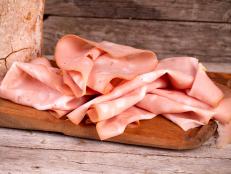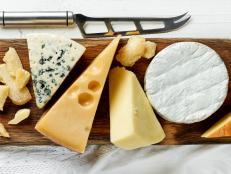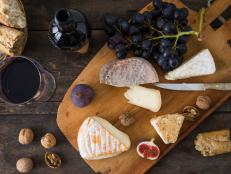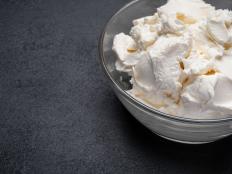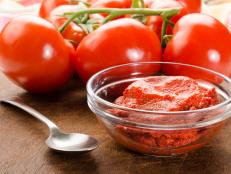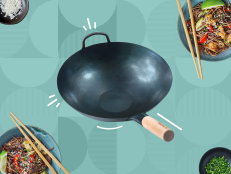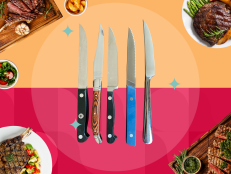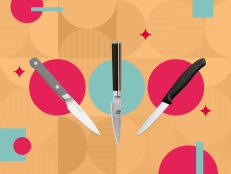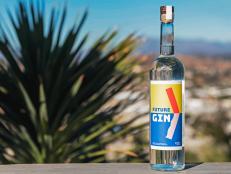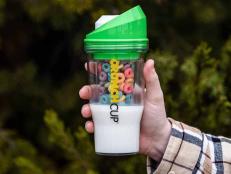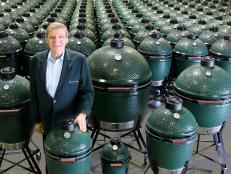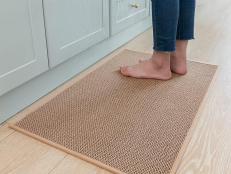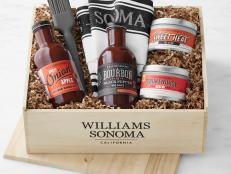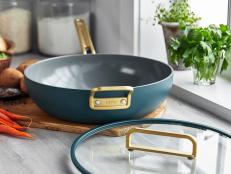What Is Burrata?
Burrata's inside is lush and velvety, flowing slowly and gently like cold cream lava. A cheese monger waxes poetic about this Italian cheese, giving you all the info you need to know.

barmalini/Getty Images
You may already know burrata cheese for its irresistible creamy center. Many restaurants add the delicacy to salads, pastas and pizzas. But what exactly is it? For more info, we consulted Stevie Lee Webb, co-founder and head cheese monger of The Cheese Shop in Carrboro, NC.
What Is Burrata?
Burrata is a mild, semi-soft, fresh cheese with a firm outer layer and creamy, spreadable interior that originated in Southern Italy. Burrata is a ball of fresh mozzarella (made with either water buffalo or cow’s milk) filled with stracciatella, a mix of shredded mozzarella and cream.
“Burrata was created by wily cheesemakers as an ingenious way of using up any leftovers from the day before,” Webb explains. “A ball of fresh mozzarella is stretched out and filled with stracciatella, a mixture of yesterday's shredded mozzarella blended with heavy cream, seasoned with salt and then sealed like a cute dairy purse. When you cut into it, the stracciatella oozes out like the yolk of a perfectly poached egg.”

Karisssa/Getty Images
What Does Burrata Taste Like?
Burrata tastes milky, rich and buttery with a subtle, creamy sweetness. “The mozzarella itself should be light and pillowy, just yielding to the teeth. The stracciatella inside should be lush and velvety, flowing slowly and gently like cold cream lava,” Webb says. “A good burrata will be made with only the finest quality milk and cream; you'll get that sweet grassiness, mild but never dull. On the back end of the cheese, you'll get the tangy and umami notes, like light-but-rich yogurt, that'll make you want to take another bite right away.”
How Is Burrata Made?
Burrata is made by filling a ball of fresh mozzarella with stracciatella, a mixture of shredded mozzarella blended with heavy cream, seasoned with salt and then sealed. Webb shares that technically, mozzarella is made with Italian water buffalo milk; if it’s made with cow’s milk, it’s called fior di latte, which translates to the flower of milk. Burrata can be made with mozzarella or fior di latte.
“Burrata is what they call a ‘pasta filata,’” Webb explains. “That's where you heat fresh curd and gently knead, stretch and pull the paste into a ball shape.” This is the same technique that’s used to make mozzarella; it’s one that is best done by hand and requires lots of practice and an extremely delicate touch.
“Like any good cheese, real burrata will only have four ingredients, milk, salt, rennet and cultures, with the all-important addition of first-class cream for the stracciatella,” Webb says.

istetiana/Getty Images
Burrata vs. Mozzarella: What’s the Difference?
Burrata and mozzarella are both creamy, fresh Italian cheeses, but burrata is a ball of mozzarella filled with stracciatella, aka shredded mozzarella blended with heavy cream. As a result, burrata has a creamy, spreadable interior and a slightly sweeter, richer flavor profile than mozzarella. Burrata does not hold its shape when sliced, but mozzarella does.
Burrata Substitutes
Fresh Mozzarella
The closest substitute for burrata is fresh mozzarella. However, fresh mozzarella doesn’t have the same richness or creamy center as burrata.
Easy DIY Stracciatella
“Honestly, there really is no substitute for Burrata,” Webb says. “If you can't find it, you could pretty easily make your own stracciatella by tearing up good mozzarella, mixing it with thick, heavy cream and seasoning to taste. This is best done the day before you plan to use it, so you could make a sort of deconstructed burrata.”
Webb adds that, “some people just love to eat Stracciatella all by itself, too. You can even make it the consistency you like; more cream will be runnier, more shreds will be thicker. I like it right in the middle, not like concrete and not running off the plate, but a nice, languid flow.”
Where to Buy Burrata
The best place to buy burrata or any cheese is your local cheese shop, but burrata is also easy to find in the dairy section at the supermarket or specialty cheese counter at the grocery store. “You can even get imported burrata for the real taste of Italy, though it will usually come in frozen and defrosted as it’s hard for such a fresh cheese to make such a long journey,” Webb says. “There are a couple of great domestic producers; my favorites are Narragansett Creamery and, my personal favorite, Siano."
Be sure check the ingredients label to see that it hasn't been made with acids instead of enzymes. Webb explains that if the label lists citric acid or vinegar in the ingredients, “it's really just hard milk and loses all those wonderful cheesy flavors that you're looking for. The words you're looking for would be rennet, cultures, starters and or enzymes as this is what makes the cheese, well, cheese.”

barmalini/Getty Images
How to Store Burrata
Generally, Webb says the best way to store cheese is in the cheese drawer at the back of the fridge, as it has the ideal temperature and humidity level. If you purchase a container of burrata with multiple cheeses, you can store uncut burrata in its original packaging and liquid and eat it within one to two days.
Once cut, burrata should be consumed immediately. “Burrata should be eaten fresh and not saved for leftovers; it won’t be half as good,” Webb says. “Thankfully, they are usually quite small and you can always share with someone.”

Photograph by Andrew Purcell
How to Use Burrata
Burrata is delicious eaten on its own with a drizzle of olive oil, flaky sea salt and black pepper, or you can use burrata in appetizers, seasonal salads, sandwiches, pizzas and pastas. Try using the supple, creamy orbs in summer-ready salads and sides, such as Peaches with Burrata and Prosciutto (pictured above) and Summer Panzanella Burrata Bowl. Or use torn burrata to top pizzas or sandwiches, like this best-of-both-worlds Prosciutto and Burrata Grilled Pizza Sandwiches. Burrata also makes a dreamy finish to all manner of pasta dishes, such as Rigatoni with Roasted Cherry Tomatoes and Burrata and Fusilli with Grape Tomatoes and Burrata.
“Burrata is a perfect foil for seasonal fruits and vegetables,” Webb says. “When I have burrata, I'll go to the farmers market and get what's best that week. Last week, I had it with strawberries and fresh peas, next week I'll have it with peaches; it doesn't just have to be tomatoes and basil.”
Related Links:























